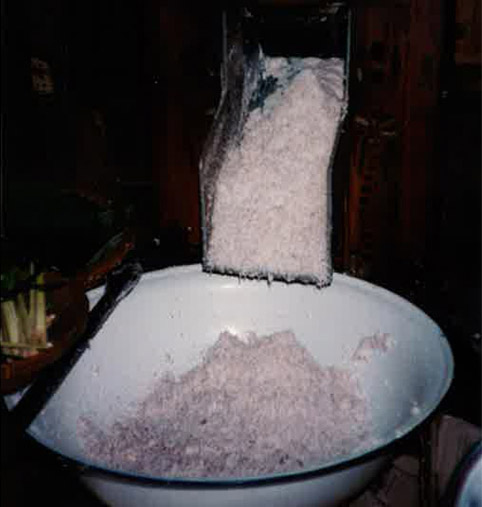
It was with Bob that I tasted my first durian. These days, I see durians everywhere in Chinatown, but in the late 1980s the durian had reached mythic status—the stinky fruit that was too smelly to be brought aboard airplanes. Trying durian for the first time is a bit like your hope for your first encounter with sex: You want to be with someone who knows what they're doing. So I lined up Halliday, purchased a durian around the corner from his apartment, and he pried open the thorny outer covering.
What was it like? After all the buildup to "the durian experience" I can't say it was a letdown, because I almost liked the creamy yellow flesh that lay inside the prickly rind. I certainly didn't find it anywhere near as disgusting as I'd been warned it would be. In texture and flavor it reminded me of a ripe Camembert cheese, and as long as I didn't think of it as a sweet fruit, I could begin to understand why it was so prized in Asia.
My week at cooking school in Thailand did two things: It whetted my appetite for more—I was quite smitten—and it humbled me into realizing how much I didn't know. That didn't stop me from turning the little piece Montant had suggested I write into a 3,000–word article, not including the accompanying ten recipes, which took almost four more full pages of text.
When it came time to run through the recipes in our Gourmet test kitchen, I had a hard time tracking down the ingredients, even in Chinatown. I had to comb the streets, looking for the telltale Thai script or Vietnamese writing on store awnings, and pester shopkeepers with questions. Thai food was still new and exotic in New York City, so the kaffir lime leaves, fresh holy basil, or lemongrass were often hidden in the back or frozen, and you had to ask for them. Repeatedly.
Today, you need go no farther than your neighborhood supermarket for ready–made curry pastes, canned coconut milk, bottles of fish sauce, and bags of rice noodles. Even if you want to be a DIYer and make your own curry pastes, you can find everything you need fresh in Southeast Asian markets, many generic Asian stores that had previously been strictly Chinese, and most surprising of all, even in upscale supermarkets with exotic produce sections.
There is one lesson from my trip that, 25 years later, remains at the center of my culinary existence: the importance of balancing flavors within every dish. There's nothing revolutionary about this—it's the core principle in all cuisines—but in Thai cooking it's heightened. The major players are so very unsubtle—the salty funk of fish sauce and shrimp paste, the sourness of tamarind or lime juice, the citrusy perfume of kaffir lime leaves, the sweetness of palm sugar and coconut milk, the jazzy kick of fresh herbs, and the heat of chiles and peppercorns—so the art of bringing them together to create something complex and delicious takes skill and practice.
It's working at balancing everything I cook that makes my time in the kitchen so much fun. I'm constantly tasting, thinking, and adjusting. When I throw together a salad dressing, for example, I offset the shrill of the lemon or lime juice with a little anchovy paste and sea salt, add sweetness with some minced shallots or a smidgen of maple syrup, and some body and heat with a little mustard, all before whisking in some olive oil. Then I taste it again and keep adjusting until I love it. That's what I call satisfaction.
Kemp Minifie was wrapped up in all aspects of food at Gourmet magazine for 32 years, and is now part of the Epicurious team.


 Pinterest
Pinterest


